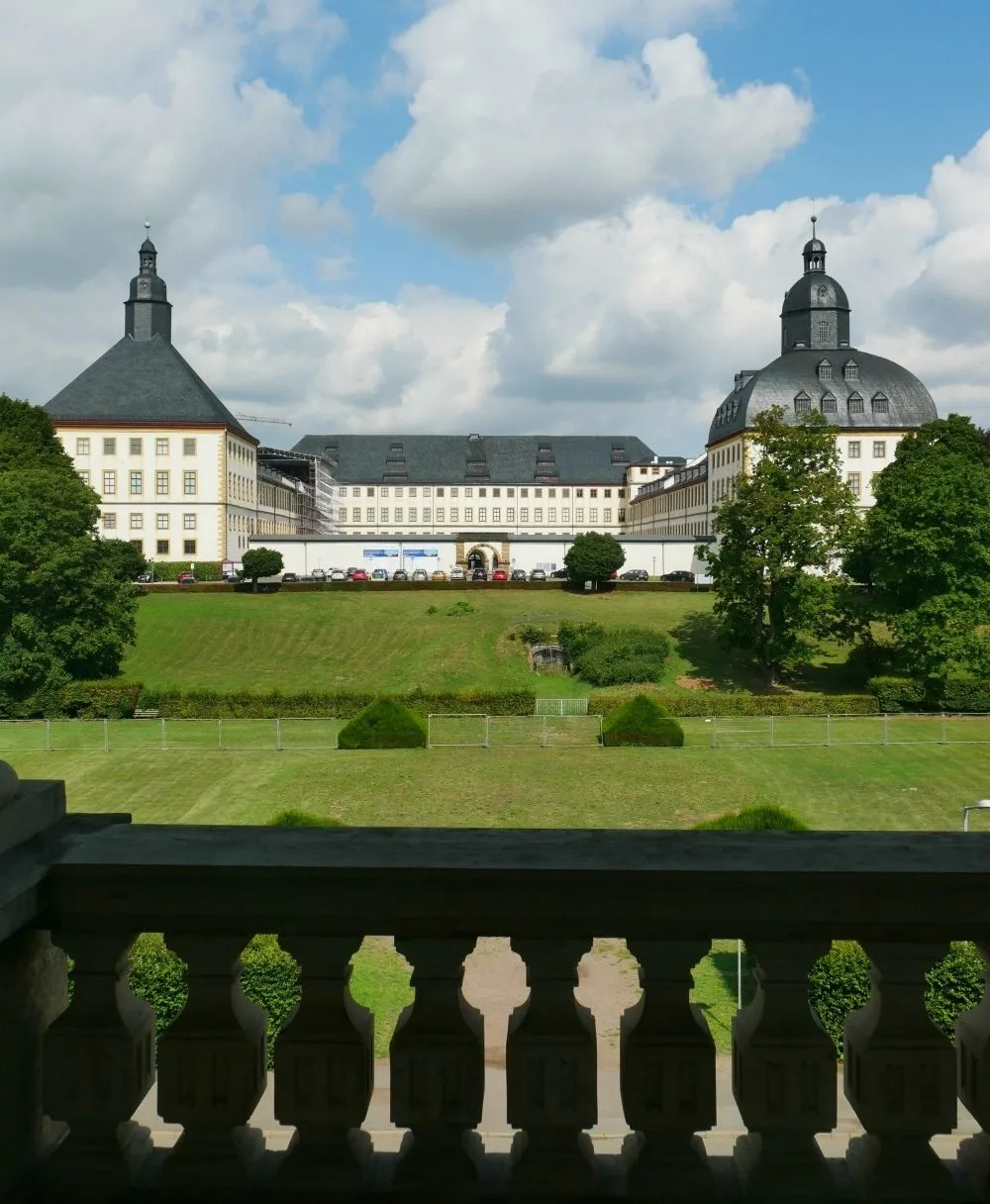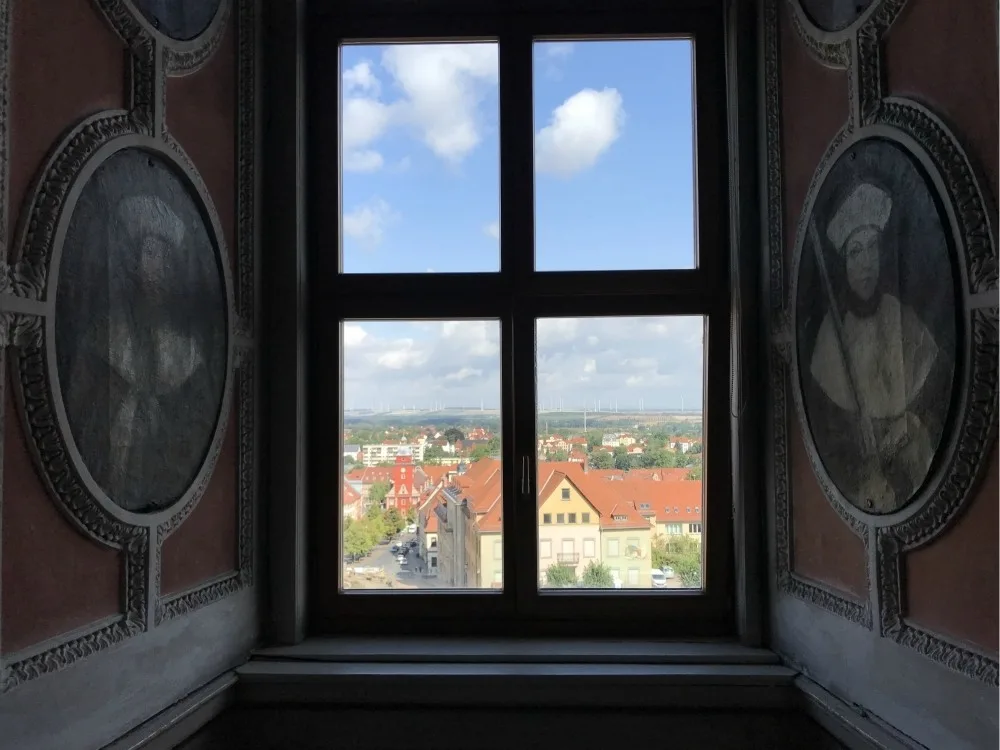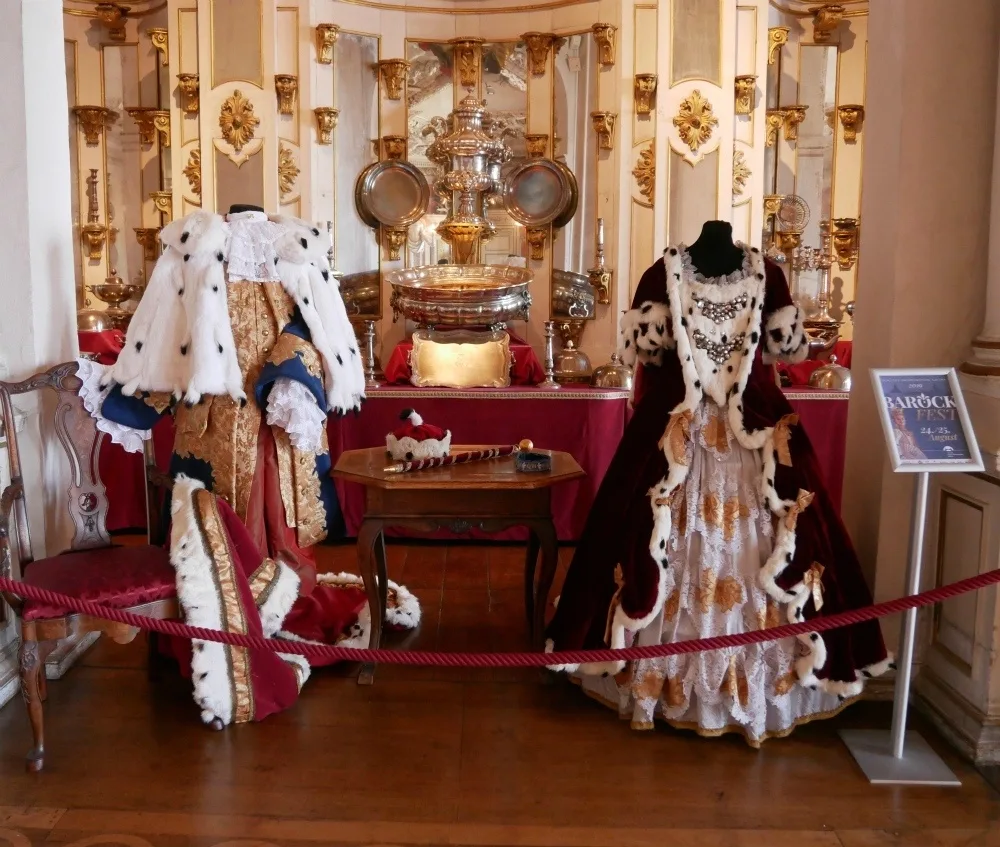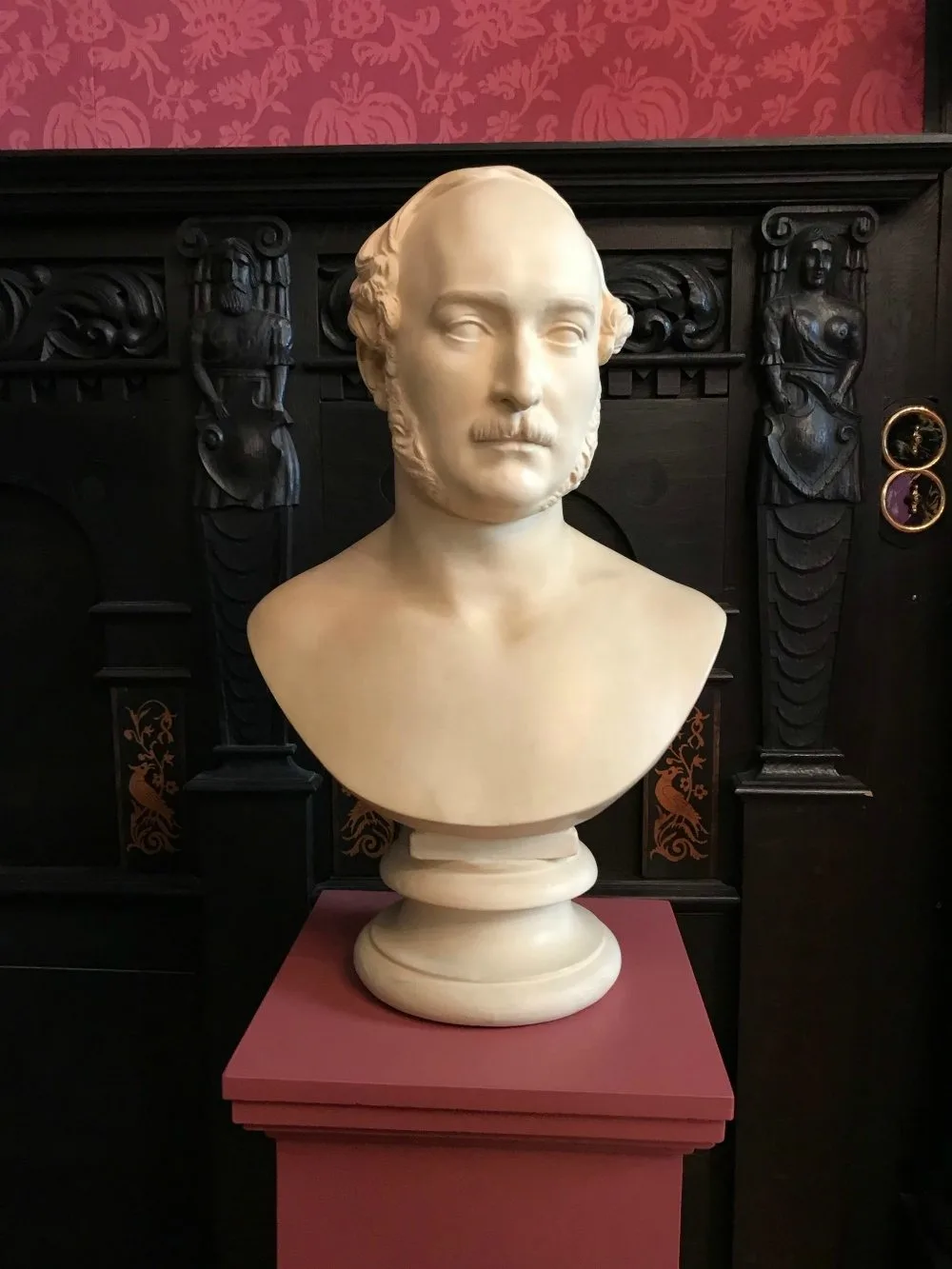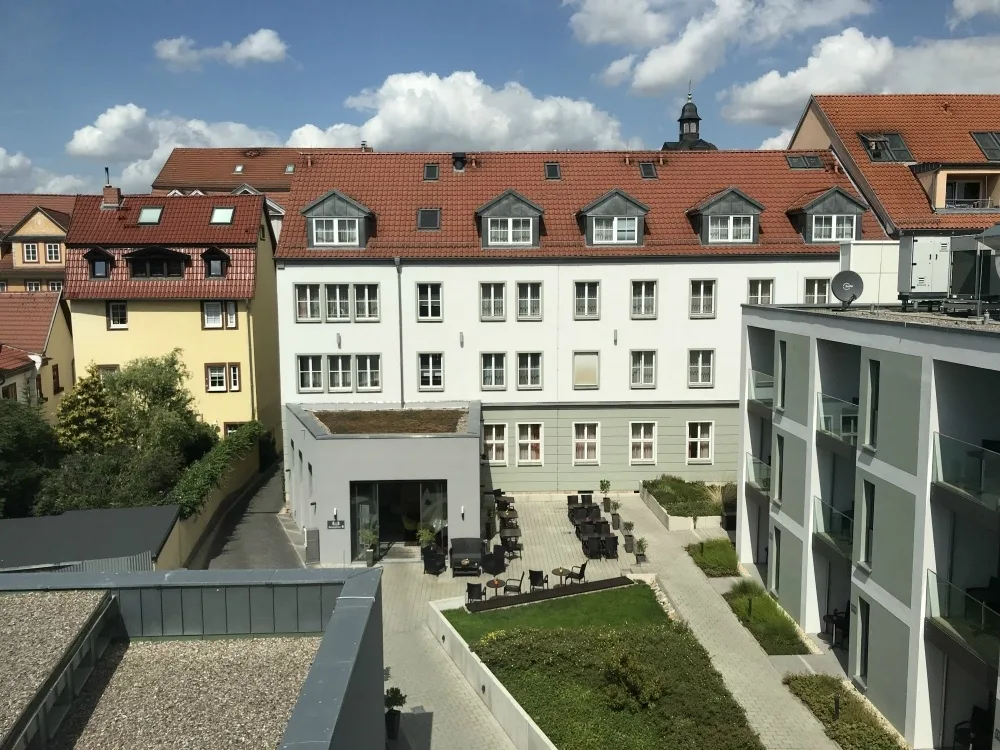Designed-to-impress Schloss Friedenstein sits overlooking the town of Gotha. This region of Thuringia is packed with castles and palaces, known as the Cultural Heart of Germany.
I was visiting during the bicentenary year of the birth of Queen Victoria and Prince Albert of Saxe-Coburg and Gotha. Special exhibitions celebrated the connections between Friedenstein Palace and the English Royal family.
If you’ve watched the TV series about Victoria and Albert, you may know that they were first cousins. Both were born in 1819 and they held their German relatives at Gotha in great affection. They sent frequent gifts to reinforce the family ties.
This article may contain affiliate links that provide commission on purchases you make at no extra cost to you. As an Amazon Associate I earn from qualifying purchases.
History of the Schloss Friedenstein in Gotha
The palace was completed in 1683 by Duke Ernest the Pious to replace the ruins of the fortress Grimmenstein. Following the Thirty Year War it was given the hopeful name of Friedenstein, meaning “Rock of Peace”.
Where previous castles had been for warfare, this was to be a new residence that was fitting for the rulers of Gotha in peacetime. Its interiors were modelled in the fashionable Baroque style of the time.
The state of Thuringia and adjoining Saxony have so many castles and palaces that they are known as the Cultural Heart of Germany. It’s worth a quick history lesson to understand why.
At that time the German speaking lands did not exist as one country, but were divided into numerous self governing states. Through the generations states were divided, their lands becoming smaller and smaller. Still, each ruling house needed a palace such as Friedenstein as a symbol of their power and authority.
You may also enjoy: A weekend in Coburg, Germany – castles and royal connections
It seems surprising that these small and sometimes impoverished German states had such strong connections with the English crown. However being Protestant, they offered suitable matches for the English royal family who were limited by religion in who they could marry.
Rulers like Duke Ernest the Pious and his wife Elizabeth Sophie were keen to exploit this benefit. Through advantageous marriages they became known as “The Grandparents of Europe.”
These marriage connections continued to one of the best known matches, of Queen Victoria of England with her first cousin, Albert of Saxe-Coburg and Gotha. Albert spent much of his early life at Friedenstein Palace.
Advantageous marriages
Other advantageous royal marriages included Princess Augusta of Saxe-Gotha who in 1736 had married Frederick, the English Prince of Wales. Her son later became King George III.
Augusta welcomed her nephew Ernest of Saxe-Gotha to visit her in London. After visiting Kew Gardens and other royal estates he later created the gardens behind the Friedenstein Museum in the romantic English landscape style.

Stay at the Hotel Am Kaisersaal in Erfurt
Search for hotels in Gotha or other hotels in nearby Erfurt
Prince Leopold, the uncle of both Victoria and Albert had married Princess Charlotte of Wales. After her death he returned to Coburg and continued the matchmaking that brought Victoria and Albert together.
Princess Victoria’s own mother was of the house of Saxe-Coburg. She was sister to Prince Leopold and Albert’s father Ernest I of Saxe-Coburg and Gotha.
So the marriage of Victoria and Albert was part of a web of family connections that linked the house of Saxe-Coburg and Gotha with the English Royal family over many generations.
You may also enjoy: 15 fun things to do in Dresden – in just one day!

There was plenty to enjoy in the state apartments at Schloss Friedenstein. We swooshed along wearing special slippers, to protect the original parquet wood floors of the palace.
Rooms like the state reception room were designed to impress. Their ornate decoration, sparkling chandeliers and portraits of the relatives and ancestors of the Dukes of Saxe-Gotha demonstrated their powerful family connections.
Through the windows we looked down on the town of Gotha. This was a reassuring sight for the Dukes who could know that they ruled everything as far as the eye could see.
The Baroque style of Friedenstein Palace
Nowhere is the Baroque style of Schloss Friedenstein more apparent than in the ballroom which was used for grand receptions and parties. In the Baroque style, it boasts ornate plasterwork, gilding and general exuberance of colour and decoration.
This was at the height of fashion between 1680 and 1750, when the rulers of central Europe competed with each other to build the most magnificent palaces. If you enjoy the joyful, over-the-top style of Baroque, you’ll find plenty of other examples in Thuringia and Saxony. Check out the Zwinger Palace and Museum in Dresden.
To see the passion for Baroque brought to life, you might want to time your visit with August. Opulent 18th century costumes and powdered wigs are being worn at the Baroque Fest that takes place in the palace courtyards.
The Dukes and Duchesses of Saxe-Gotha-Altenburg step out from their portraits and are brought to life. They preside over events and welcome their guests during the festival. Food and local crafts are on sale, with carriage rides through the palace grounds and musical events and fireworks at the weekends.
You may also enjoy: Christmas in Coburg: discovering the seasonal magic in Germany
The Friedenstein Palace Ekhof Theatre
Continuing the Baroque theme at Friedenstein Palace, be sure to visit the Ekhof Theatre . Completed in 1687, it still uses the original 17th century scenery and stage machinery.
This jewel box of a theatre is used for the Ekhof Festival, taking place in July and August each year. It features performances of Baroque music and plays in their authentic setting.
In the adjoining rooms there’s a small exhibition space with some of the theatrical costumes and other objects of interest from the theatre. More information: Ekhof Festival website
The Victoria and Albert connection with Friedenstein
One of the things I enjoyed most on our visit was the connections of Friedenstein Palace with Queen Victoria and Prince Albert. This is displayed in the many portraits and other keepsakes in the palace collections.
Friedenstein was one of the residences used by Prince Albert parents: his father Duke Ernest I of Saxe-Coburg-Saalfeld and mother Luise of Saxe-Gotha-Altenburg. The marriage of Ernest I and Luise was itself an advantageous match. Luise was the heiress to Gotha and on her marriage the estates and title were combined with those of Saxe-Coburg.
I couldn’t help feeling sorry for Luise who was only 17 when she married a husband twice her age. Just a teenager, she had a romantic vision of Ernest as her knight in shining armour.
Their two children Ernest and Albert were quickly born a year apart. Sadly, the marriage ended in much unhappiness when a scandal was triggered by Ernest I’s infidelities. Probably thinking how she could punish her husband, Luise was also suspected of taking a lover.
You may also enjoy: A guide to Wartburg Castle and Eisenach – on the Martin Luther Trail in Germany
Paintings and portraits of ancestors
There’s a charming portrait of Luise with her two sons, Albert and Ernest that was completed in 1824. Shortly afterwards the scandal broke that caused their separation.
Ernest banned Luise from the court of Coburg and she was not allowed to see her children again. Sadly, she died of cancer when she was only 30 years old. In those days the power was all on the man’s side. Ernest retained the lands and title of Gotha, even though Luise was forbidden to even see her sons.
With no contact with his mother, Prince Albert became fond of his step-grandmother the Dowager Duchess Karoline Amalie. She lived at Friedenstein Palace and Albert often visited her there.
Prince Albert’s marriage to his cousin Queen Victoria meant that he had to give up his homeland, but he was very homesick. As he set off for England in 1839 he wrote to his brother Ernest, “Yesterday we left Coburg, you possibly cannot imagine how the last real farewell cuts my heart. The youth lies behind me”.
Albert’s final stop was Schloss Friedenstein, where he celebrated New Years Eve, was invested with the English Order of the Garter. His portrait was painted here, so that an engraving could be made for the British people to see their Queen’s future husband.
Queen Victoria appreciated Albert’s longing for his former home. She later commissioned the German painter Friedrich Rothbarth to make a series of watercolours of the princely apartments at Friedenstein Palace that would have been so familiar to Albert from his childhood days.
Portraits and paintings as gifts
As birthday and Christmas gifts, Queen Victoria would commission paintings and watercolours of family members. These were sent to her extended family in Germany, much as we might send photos today. Family portraits were often copied several times with versions sent to hang proudly in all the palaces of their relations.
You may also enjoy: Delicious food in Heidelberg – where and what to eat in Heidelberg, Germany
In the rooms of Friedenstein, some of these family portraits can still be seen. View Landseer portraits of Victoria and the charming picture of their oldest children Princess Victoria and Albert Edward as toddlers, playing with their dog.
Prince Albert and Queen Victoria also visited Friedenstein several times and the queen thought of her visits to Thuringia with much affection. This was a place where she could be herself, away from the spotlight of the English Court.
The dynasty of Saxe-Coburg and Gotha continued through the marriages of Victoria and Albert’s own children. Connections spanned Europe with the royal houses of Belgium, Bulgaria, Germany, England, France, Portugal, Russia, Sweden and Hungary.
Many of the gifts of portraits, sculptures and even keepsakes like a lock of hair are on display in the collections at Friedenstein.
The Ducal Museum at Friedenstein
From the palace you can look across the gardens to the Ducal Museum. It was built between 1864 and 1879 by Prince Albert and his brother Ernest. The museum was conceived by the brothers as a place that the collections and treasures of the Dukes of Saxe-Coburg and Gotha could be properly displayed and shown to a wider public.
Both brothers loved collecting, a habit formed on their childhood walks through the Thuringian forest. They would pick up objects from nature or observe geological formations.
Over the centuries it was fashionable for the wealthy to collect an eclectic mix of objects. Not only art and sculpture but exotic objects from around the world.
In the days before internet this was the way of sharing information about what was to be found in distant and mysterious lands. Lands far beyond the boundary of Saxe-Coburg or even Europe.
Prince Albert had sponsored the great public museums of Science, Natural History and the Arts in South Kensington, London. So, Gotha would now have its own equivalent to showcase their own collections.
Prince Albert’s death in 1861
Sadly Prince Albert died in 1861 before the museum was started, but the project was completed by Ernest as a tribute to his brother. The museum contains many beautiful artworks, treasures from around the world and a collection of fans.
There are often special exhibitions here including the one that was running through the summer of our visit, about Gotha and the English Throne. For this exhibition, many of the royal portraits in the collection of Schloss Friedenstein had been gathered together
These tell the story of the connections with the English Royal family that stretched back to the 18th century. From the marriage of Princess Augusta of Saxe-Gotha to the English Prince of Wales as well as the match between Queen Victoria and Prince Albert.
The Gardens of the Ducal Museum
After visiting the museum, we had a quick walk around the English Gardens. These indeed looked much like the Royal parks of London that it imitated. Here are lakes, specimen trees and naturalistic plantings, with a Roman Temple to the god Mercury completing the view across the lake.
The gardens were influenced by the visits that Ernest II of Saxe-Gotha-Altenburg made to his Aunt Augusta and the English Royal Court in 1768, when he visited Kew Gardens and other parks in London.
Visit Schloss Friedenstein in Gotha, Germany
More information on the Schloss Friedenstein Website | Open daily except Mondays 10am – 4pm Nov – March and 10am – 5pm April – Oct | Ticket €10 covers palace, museums, theatre | Audio Guides in English available €2.50
Visitor Information for your trip to Thuringia, Germany
You’ll find more information to plan your trip on The Cultural Heart of Germany Website and the Visit Thuringia website and the Gotha tourism website

Need a guide book for Germany? We recommend the DK Eyewitness Germany Travel Guide
The closest airport to Gotha with a wide range of international flights is Frankfurt, although there are smaller airports at Erfurt, Leipzig and Dresden.
We flew into Frankfurt then took the train to nearby Eisenach, where we picked up a hire car from Europcar close to the station. There is a train station at Gotha and the German rail network is very efficient, so this would be a good way to reach Gotha from other airports or regions of Germany, as an alternative to a hire car, which we used.
If you are looking for a guidebook for your visit to Thuringia and Germany, we recommend the DK Eyewitness Travel Guide to Germany.
Where to stay in Thuringia
We stayed in nearby Erfurt at Hotel Am Kaisersaal, an excellent modern hotel that’s one of a small group of Bachmann Hotels. In addition to the 85 bedrooms they offer 2 bedroom apartments for a minimum 2 night stay, which would be ideal if you want a little longer to explore the area.
Behind the traditional looking front building, the Hotel Am Kaisersaal has further modern accommodation wings, built around a pleasant grassy courtyard, with a convenient underground car park. The atmosphere was calm and friendly, with the usual excellent breakfast spread you find in Germany. Our bedroom was contemporary and well designed with a pleasant outlook over the internal courtyard.

Stay at the Hotel Am Kaisersaal in Erfurt
Search for hotels in Gotha or other hotels in nearby Erfurt
Where is Gotha and Thuringia?
Gotha is in the German state of Thuringia, which is in the centre of the country and was formerly part of the East German GDR. Thuringia is bounded by the better known Bavaria to the south and Saxony to the east. The rolling rural countryside, green belt of Thuringia forest and pretty medieval towns, castles and palaces make this an ideal road trip destination.
You can see all the places we visited on the map below.
Read Next
Learn about Wartburg Castle and Eisenach – on the Martin Luther trail in Germany
Pin it for later!
This article was sponsored* by The Cultural Heart of Germany, Thuringia Tourism and Visit Saxony who provided the 4 day trip and experiences mentioned.
* More info on my policies page
This article is originally published at Heatheronhertravels.com



